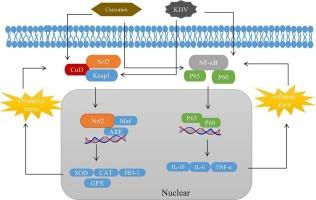姜黄素通过Nrf2-Keap1/ARE和NF-κB途径抑制锦鲤疱疹病毒(KHV)复制
IF 3.9
1区 农林科学
Q1 FISHERIES
引用次数: 0
摘要
锦鲤疱疹病毒(KHV)是一种在世界鲤鱼中引起高传染率和高死亡率的病原体。姜黄素在鱼类中具有抗氧化、抗炎和抗病毒的特性。本研究对其在锦鲤体内的预防作用和抑制机制进行了研究。腹腔注射浓度分别为0(对照)、20、40、80 μg/g体重的姜黄素后第3天,以TCID50 = 10-6.75的浓度注射200 μL KHV。在姜黄素注射后第1、2、3天和KHV感染后第7天对鳃和肝胰脏酶活性进行评估。注射40 μg/g姜黄素后第3天抗氧化、抗炎作用最强(P < 0.05)。在感染KHV后第7天,虽然所有姜黄素浓度都能有效抑制KHV复制(P < 0.05),但40 μg/g处理对所有参数的影响最大且最显著;与阳性对照(仅注射KHV)相比,两种组织样品的超氧化物歧化酶(SOD)、过氧化氢酶(CAT)、谷胱甘肽过氧化物酶(GSH-Px)活性和总抗氧化能力(T-AOC)均显著升高(P < 0.05),一氧化氮(NO)和丙二醛(MDA)活性显著降低(P < 0.05)。同时,注射KVH后,Nrf2、Marf、CAT、SOD和HO-1基因的表达在姜黄素处理后显著上调,特别是在40 μg/g处理时。在此治疗中,与炎症反应相关的基因(如Keap 1、NF-κB、p65、IL-6和TNF-α基因)的表达明显低于KHV阳性对照组(P < 0.05)。上述结果表明,姜黄素可通过Nrf 2-Keap1/ARE和NF-κB途径有效抑制KHV复制,激活抗氧化功能,减轻氧化应激和炎症应激。该干预措施可提高感染KHV的锦鲤的存活率,因此姜黄素处理可能是控制该病的有效策略。本文章由计算机程序翻译,如有差异,请以英文原文为准。

Curcumin inhibits koi herpesvirus (KHV) replication via Nrf2-Keap1/ARE and NF-κB pathways in ornamental koi (Cyprinus carpio haematopterus)
Koi herpesvirus (KHV) is a pathogen causing high contagion rate and elevated mortality in carp in the world. Curcumin has demonstrated antioxidant, anti-inflammatory, and antiviral properties in fish species. In this study, its preventive effects against KHV and inhibitory mechanism were investigated in koi carp. On day 3 post intraperitoneal injection with curcumin at a concentration of 0 (control), 20, 40, or 80 μg/g of body weight, the fish was injected with 200 μL KHV at the concentration of TCID50 = 10–6.75. Enzyme activities in the gill and hepatopancreas were assessed on days 1, 2, and 3 after curcumin injection, and on day 7 following KHV infection. The highest antioxidant and anti-inflammatory effects were observed on day 3 after injection with 40 μg/g curcumin (P < 0.05). On day 7 after KHV infection, although all curcumin concentrations showed effectiveness in suppressing KHV replications (P < 0.05), the 40 μg/g treatment resulted in the highest and significant changes in all the parameters measured; in comparison with the positive control (KHV injection only), the activities of superoxide dismutase (SOD), catalase (CAT), glutathione peroxidase (GSH-Px) and total antioxidant capacity (T-AOC) in both tissue samples increased significantly (P < 0.05) whereas the activities of nitric oxide (NO) and malondialdehyde (MDA) reduced significantly (P < 0.05). Concurrently, the expressions of Nrf2, Marf, CAT, SOD and HO-1 genes were significantly upregulated in curcumin treatments following the KVH injection, especially in the 40 μg/g treatment. In this treatment, the expressions of genes involving in inflammatory responses (e.g. Keap 1, NF-κB, p65, IL-6 and TNF-α genes) were significantly lower than those in the KHV positive control (P < 0.05). These findings indicate that curcumin could effectively inhibit KHV replications, activate antioxidant functions and alleviate both oxidative and inflammatory stresses via the Nrf 2-Keap1/ARE and NF-κB pathways. As this intervention enhanced the survival of koi carp infected by KHV, curcumin treatment could be an effective strategy to manage this disease in aquaculture.
求助全文
通过发布文献求助,成功后即可免费获取论文全文。
去求助
来源期刊

Aquaculture
农林科学-海洋与淡水生物学
CiteScore
8.60
自引率
17.80%
发文量
1246
审稿时长
56 days
期刊介绍:
Aquaculture is an international journal for the exploration, improvement and management of all freshwater and marine food resources. It publishes novel and innovative research of world-wide interest on farming of aquatic organisms, which includes finfish, mollusks, crustaceans and aquatic plants for human consumption. Research on ornamentals is not a focus of the Journal. Aquaculture only publishes papers with a clear relevance to improving aquaculture practices or a potential application.
 求助内容:
求助内容: 应助结果提醒方式:
应助结果提醒方式:


